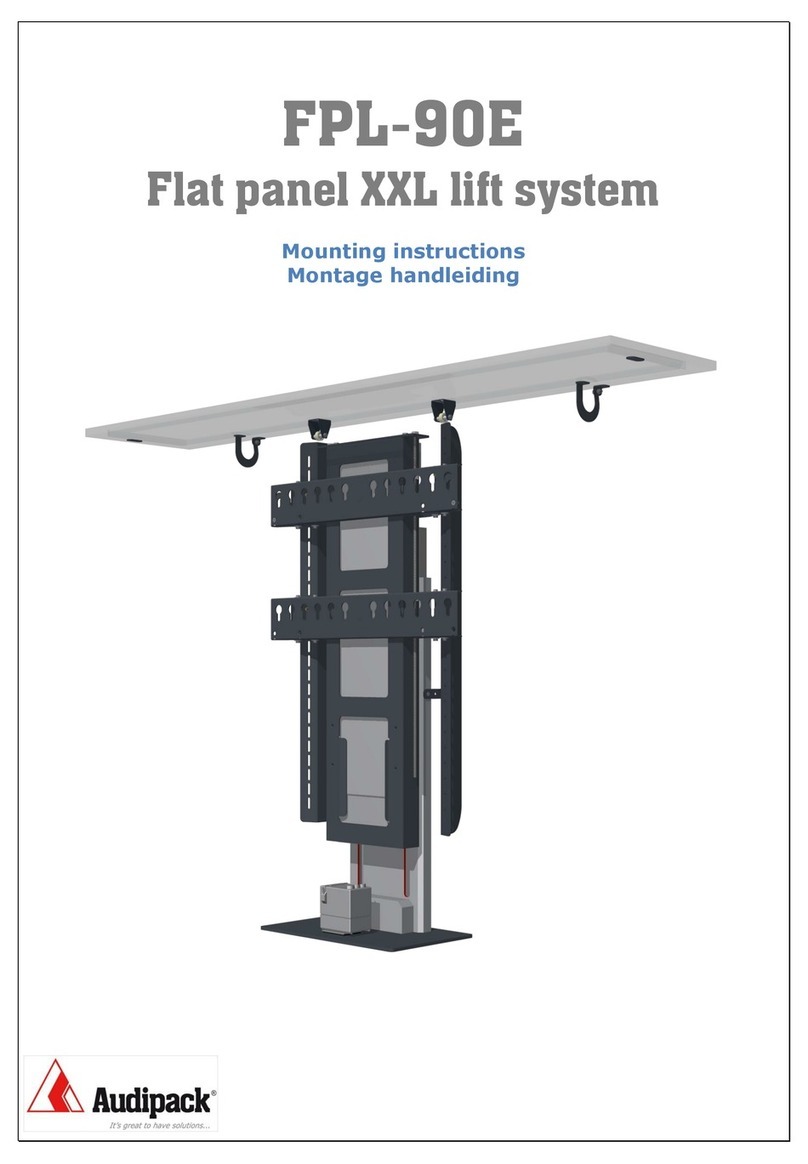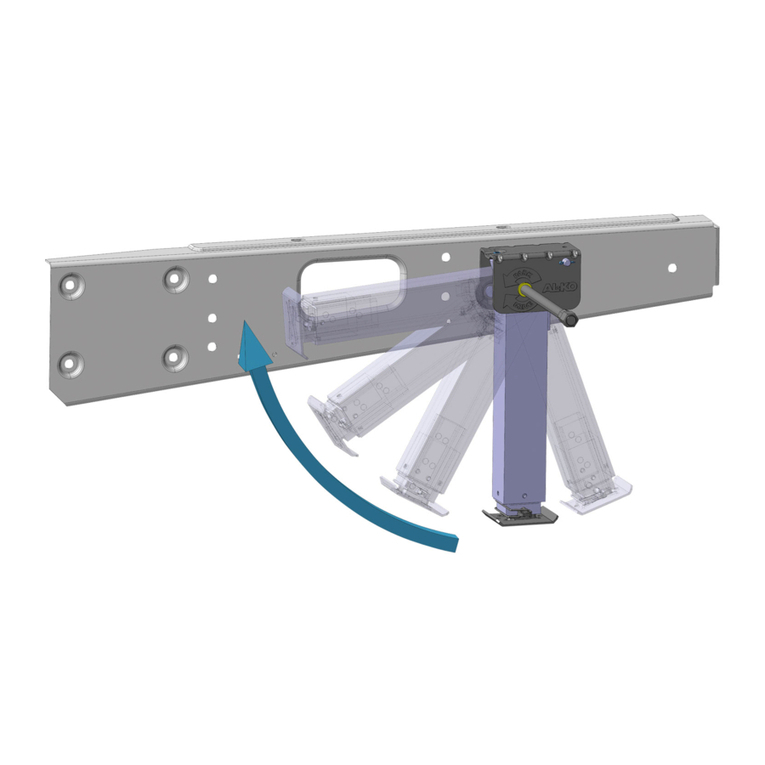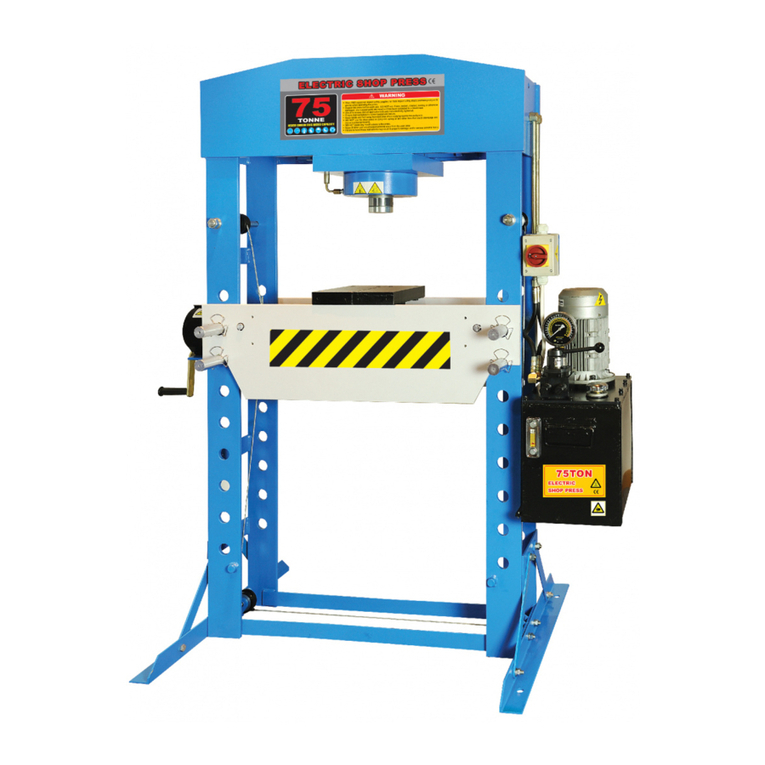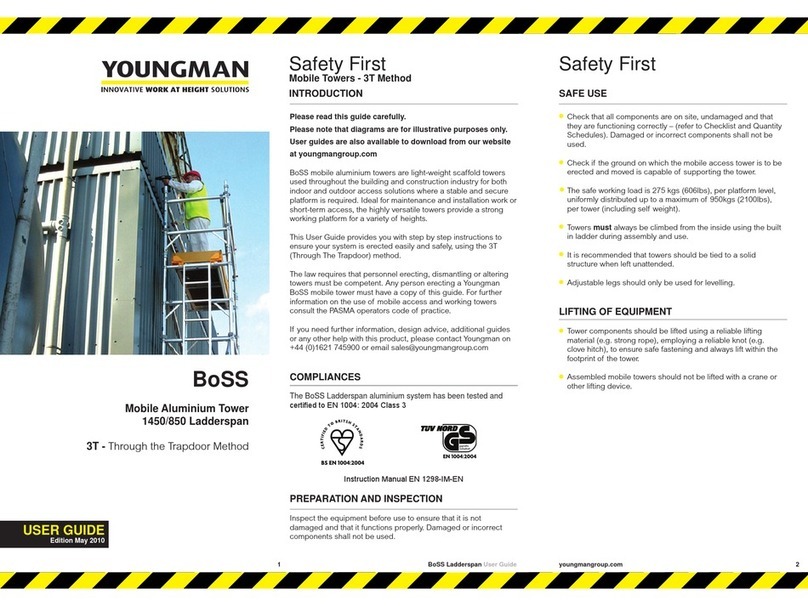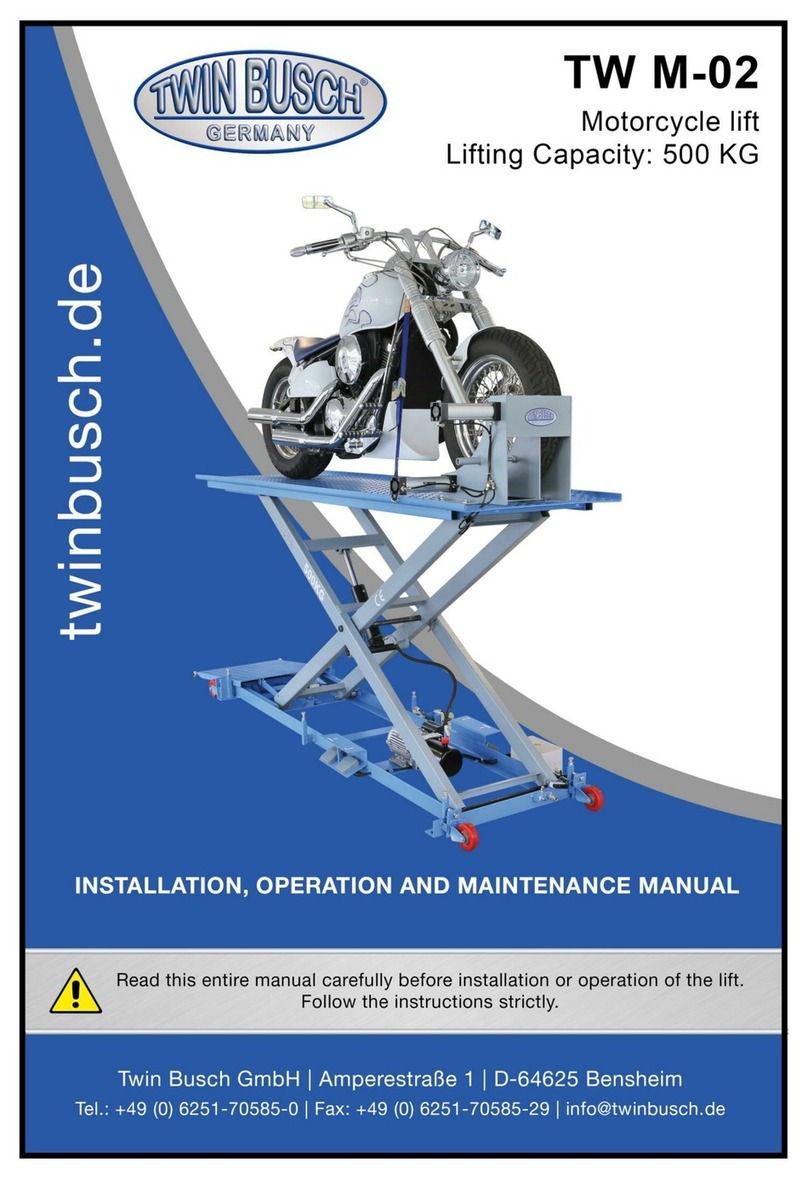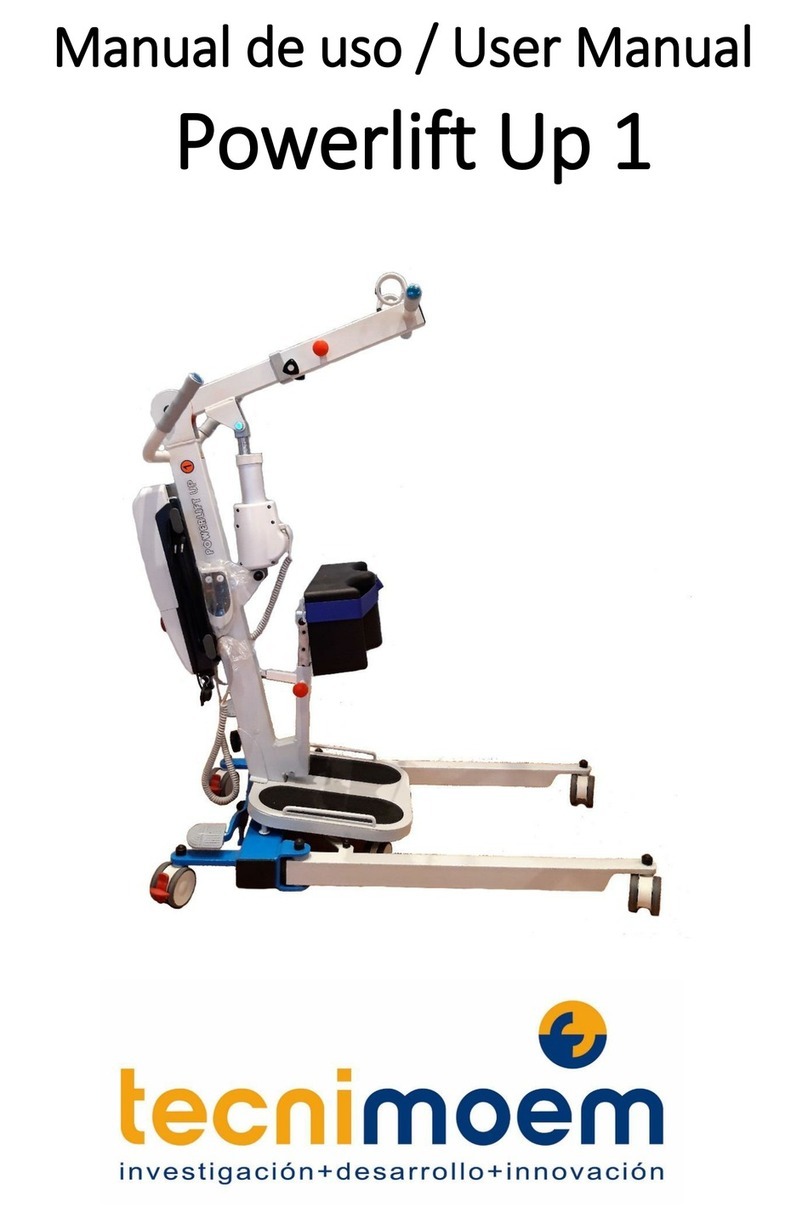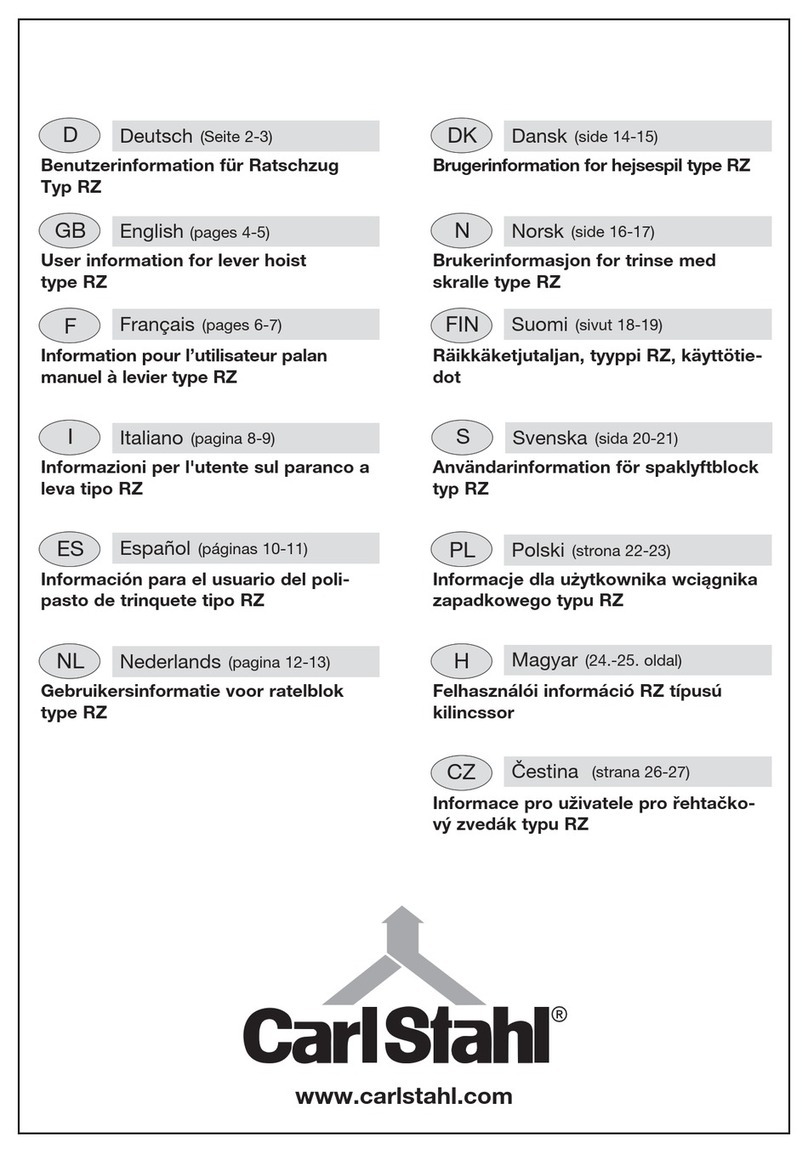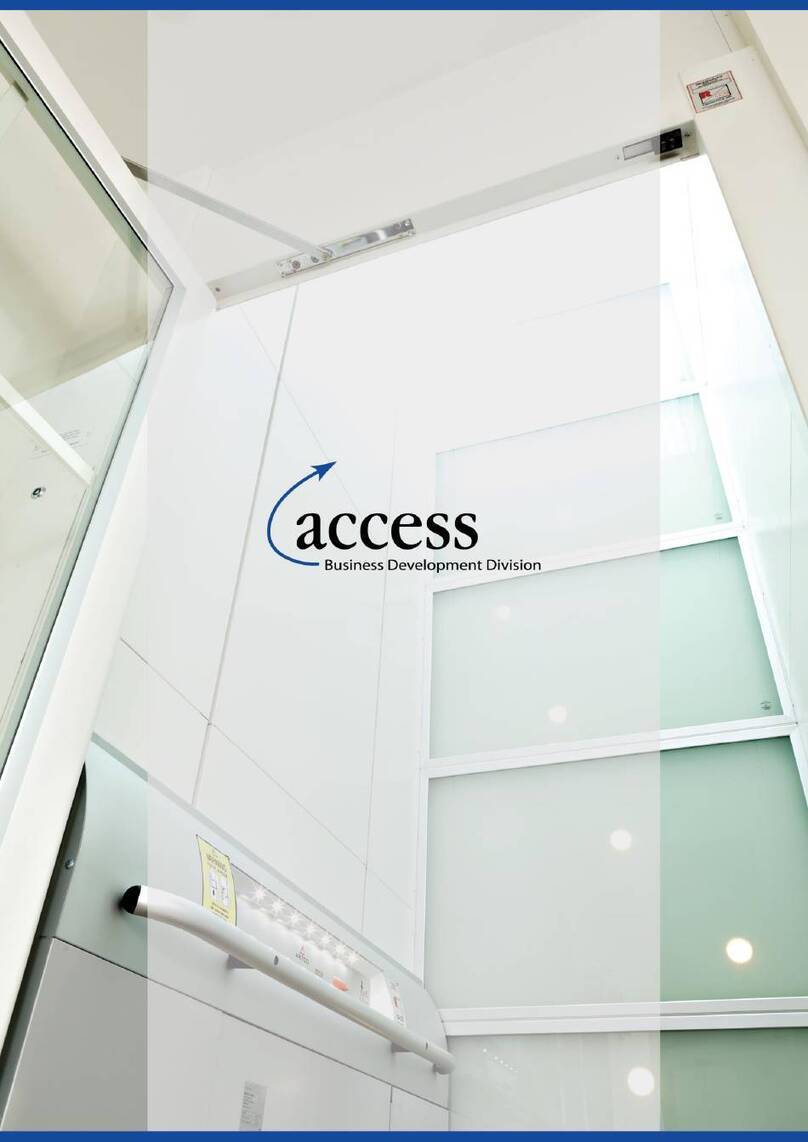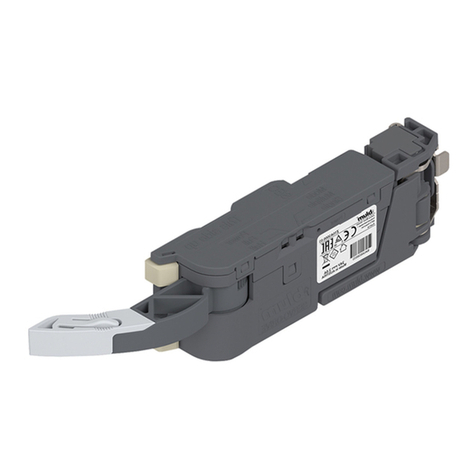DLM HED Series User manual

HED SERIES
Hydraulic EOD Dock
Leveler
Owner’s/User’s Manual
DLM • Division of Systems, Inc. • W194 N11481 McCormick Drive • Germantown, WI 53022
800.643.5424 • fax: 262.255.5917 • www.docksystemsinc.com • [email protected]
Printed in U.S.A.
Copyright © 2009
Manual No. 4111-0027
Sept. 2010
May 2012

2
Page
Safety
Recognize Safety Information ............................................................. 1
General Operational Safety Precautions ............................................ 1
Operational Safety Precautions........................................................... 2
Maintenance Safety Precautions......................................................... 4
Safety Decals......................................................................................... 5
Owner’s User’s Responsibilities ......................................................... 6
Introduction
General Information.............................................................................. 7
Dock Leveler Stock Specifications ..................................................... 7
Component Identification..................................................................... 8
Installation
Installation Details ................................................................................ 10
Flush Mount-Weld On.......................................................................... 12
Ramp Mount - Weld/Bolt On .............................................................. 14
Flush Mount - Bolt On ........................................................................ 16
Ramp Mount - Weld On w/Formed Angle ......................................... 18
Formed Angle...................................................................................... 20
Ramp and Face Plate.......................................................................... 22
Installation Check List .........................................................................24
Install Control Panel and Wiring ........................................................26
Put New Dock Leveler Into Service .................................................. 27
Operation
Operating Instructions ....................................................................... 28
Maintenance
Periodic Maintenance ......................................................................... 30
Adjustments
Adjust Main Pressure Relief .............................................................. 33
Adjust Lip Function ............................................................................ 34
Electrical
Single Phase........................................................................................ 36
Three Phase......................................................................................... 37
Troubleshooting
Troubleshooting.................................................................................. 38
Parts
HED Series........................................................................................... 40
Bumper Components ......................................................................... 42
Miscellaneous
Customer Information ........................................................................ 45
Warranty................................................................................ Back Cover
Table of Contents

1
Manual No. 4111-0027
Sept. 2009
May 2012
O
p
e
r
a
t
i
n
g
Z
o
n
e
O
p
e
r
a
t
i
n
g
Z
o
n
e
1
SAFETY
Recognize Safety Information
Read and understand the operating instructions and
become thoroughly familiar with the equipment and its
controls before operating the dock leveler.
Never operate a dock leveler while a safety device or
guard is removed or disconnected.
Never remove DANGER, WARNING, or CAUTION
signs or decals on the equipment unless replacing
them.
General Operational Safety
Precautions
Do not start the equipment until all unauthorized
personnel in the area have been warned and have
moved outside the operating zone.
Remove any tools or foreign objects from the operating
zone before starting.
Keep the operating zone free of obstacles that could
cause a person to trip or fall.
The use of the word DANGER signifies the presence
of an extreme hazard or unsafe practice which will
most likely result in severe injury or death.
Safety-Alert Symbol
The Safety-Alert Symbol identifies important safety
messages on equipment, safety signs, in manuals,
or elsewhere. When you see this symbol, be alert to
the possibility of personal injury or death. Follow the
instructions in the safety message.
The use of the word WARNING signifies the
presence of a serious hazard or unsafe practice
which may result in serious injury or death.
IMPORTANT
The use of the word IMPORTANT is to draw
attention to a procedure that needs to be followed to
prevent machine damage.
The use of the word CAUTION signifies possible
hazard or unsafe practice which could result in
personal injury.

2Manual No. 4111-0027
Sept. 2009
May 2012
2
SAFETY
Learn the safe way to operate this equipment. Read and understand the
manufacturer’s instructions. If you have any questions, ask your supervisor.
Operational Safety Precautions
Stay clear of dock leveling device when freight
carrier is entering or leaving area.
Do not move or use the dock leveling device if
anyone is under or in front of it.
Keep hands and feet clear of pinch points. Avoid
putting any part of your body near moving parts.
Chock/restrain all freight carriers. Never remove
the wheel chocks until loading or unloading is
finished and truck driver has been given permission
to drive away.
Do not use a broken or damage dock leveling
device. Make sure proper service and maintenance
procedures have been performed before using.
Make sure lip overlaps onto trailer at least 4 in.
(102 mm).
Keep a safe distance from both side edges.

3
Manual No. 4111-0027
Sept. 2009
May 2012
3
Do not use dock leveling device if freight carrier is
too high or too low.
Do not overload the dock leveling device.
Do not operate any equipment while under the
influence of alcohol or drugs.
Do not leave equipment or material unattended on
dock leveling device.
SAFETY

4Manual No. 4111-0027
Sept. 2009
May 2012
4
SAFETY
Maintenance Safety Precautions
ALWAYS disconnect electrical power source and
ground wire before welding on dock leveler.
DO NOT ground welding equipment to any hydraulic
or electrical components of the dock leveler. Always
ground to the dock leveler frame.
Failure to follow these instructions may result in
damage to dock leveler and/or serious personal
injury or death.
ALWAYS stand clear of dock leveler lip when
working in front of the dock leveler. Failure to do this
may result in serious personal injury or death.
DO NOT grind or weld if hydraulic fluid or other
flammable liquid is present on the surface to be
ground or welded
DO NOT grind or weld if uncontained hydraulic fluid
or other flammable liquid is present. Stray sparks
can ignite spills or leaks near the work area. Always
clean up the oil leaks and spills before proceeding
with grinding or welding.
Always keep a fire extinguisher of the proper type
nearby when grinding or welding.
Failure to follow these instructions may result in
serious personal injury or death.
Hydraulic and electrical power must be OFF when
servicing the equipment. For maximum protection,
use an OSHA approved locking device to lock
out all power sources. Only the person servicing
the equipment should have the key to unlock the
device.
Always post safety warnings and barricade the
work area at dock level and ground level to prevent
unauthorized use of the unit before maintenance is
complete.

5
Manual No. 4111-0027
Sept. 2009
May 2012
5
SAFETY
Safety Decals
1
3
2
2
Unsupported dock leveler
ramps can lower unexpectedly.
Before allowing vehicle to leave
the dock always:
Ensure that no equipment,
material or people are on the
dock leveler.
Return the dock leveler to its
stored position at dock level.
Failure to follow posted instructions will result in death or serious injury.
SAFETY INFORMATION
Call 262.255.1510 for replacement placards, warning labels, or owner’s/user’s manuals.
Operation
1. Read and follow all instructions and
warnings in the owner’s/user’s
manual.
2. Use of dock leveler restricted to
trained operators
3. Always chock trailer wheels or
engage truck restraint before
operating dock leveler or beginning to
load or unload.
4. Never use hands or equipment to
move the ramp or lip
5. Before activating dock leveler:
Ensure trailer is backed in against
bumpers.
Remove any end loads if required.
Check trailer alignment to avoid lip
interference. If lip does not lower to
trailer bed, reposition vehicle.
6. Ensure that truck bed supports
extended lip or the leveler frame
Supports the ramp before driving on
ramp.
7. Stay clear of hinges and front and
sides of moving dock leveler.
8. Never use damaged or
malfunctioning dock leveler. Report
problems immediately to supervisor.
Maintenance/Service
1. Read and follow all instructions,
warnings and maintenance schedules
in the owner’s/user’s manual.
2. Maintenance/Service of dock leveler
restricted to trained personnel.
3. Place barriers on the driveway and on
dock floor to indicate service work is
being performed.
4. DO NOT ENTER PIT unless dock
leveler is securely supported by
maintenance prop.
5. If electrically powered turn off and use
OSHA lockout/tagout procedures.
DANGER
Unsupported dock leveler
ramps can lower unexpectedly.
Before allowing vehicle to leave
the dock always:
Ensure that no equipment,
material or people are on the
dock leveler.
Return the dock leveler to its
stored position at dock level.
Failure to follow posted instructions will result in death or serious injury.
SAFETY INFORMATION
Call 262.255.1510 for replacement placards, warning labels, or owner’s/user’s manuals.
Operation
1. Read and follow all instructions and
warnings in the owner’s/user’s
manual.
2. Use of dock leveler restricted to
trained operators
3. Always chock trailer wheels or
engage truck restraint before
operating dock leveler or beginning to
load or unload.
4. Never use hands or equipment to
move the ramp or lip
5. Before activating dock leveler:
Ensure trailer is backed in against
bumpers.
Remove any end loads if required.
Check trailer alignment to avoid lip
interference. If lip does not lower to
trailer bed, reposition vehicle.
6. Ensure that truck bed supports
extended lip or the leveler frame
Supports the ramp before driving on
ramp.
7. Stay clear of hinges and front and
sides of moving dock leveler.
8. Never use damaged or
malfunctioning dock leveler. Report
problems immediately to supervisor.
Maintenance/Service
1. Read and follow all instructions,
warnings and maintenance schedules
in the owner’s/user’s manual.
2. Maintenance/Service of dock leveler
restricted to trained personnel.
3. Place barriers on the driveway and on
dock floor to indicate service work is
being performed.
4. DO NOT ENTER PIT unless dock
leveler is securely supported by
maintenance prop.
5. If electrically powered turn off and use
OSHA lockout/tagout procedures.
DANGER
2
2
DANGER
!
Ramp swings toward you.
Stand Clear.
Use maintenance strut while servicing.
Failure to do so will result in death or
serious injury.
1
Decal 2 will have two positions, one on the outside of the left bumper and
one on the outside of the right bumper.
Decal 4 represents the placement of the serial tag.
DANGER
!
CRUSH HAZARD
DO NOT REMOVE hydraulic cylinder until leveler is
safely supported by maintenance prop. Refer to
owner’s/user’s manual for proper maintenance
procedure. Failure to comply will result in death or
serious injury.
3
4

6Manual No. 4111-0027
Sept. 2009
May 2012
6
OWNER’S/USER’S RESPONSIBILITIES
1. The owner/ user should recognize the inherent dangers of the interface between the loading dock and
the transportation vehicle. The owner/ user should, therefore, train and instruct all operators in the safe
operation and use of the loading dock equipment in accordance with manufacturer’s recommendations
and industry standards. Effective operator training should also focus on the owner’s/user’s company
policies and operating conditions. Maintaining, updating and re training all operators on safe working
habits and operation of the equipment, regardless of previous experience, should be done on a regular
basis and should include an understanding and familiarity with all functions of the equipment. Owner’s/
user’s shall actively maintain, update and retrain all operators on safe working habits and operations of
the equipment.
2. The manufacturer shall provide to the initial purchaser all necessary information regarding Safety
Information, Operation, Installation and Safety Precautions, Recommended Initial and Periodic
Inspections Procedures, Planned Maintenance Schedule, Product Specifications, Troubleshooting
Guide, Parts Break Down, Warranty Information, and Manufacturers Contact Information, as well as
tables to identify the grade(slope) for all variations of length or configuration of the dock leveling device
and information identifying the maximum uncontrolled drop encountered when sudden removal of support
while in the working range of the equipment.
3. It is recommended that when the transportation vehicle is positioned correctly in the dock opening and
in contact with both bumpers, there shall be a minimum of 4.00 inches (100mm) overlap of the leveling
device and the transportation vehicle at all times during the loading and unloading process.
4. The Owner/User must review all name plates, placards, decals, instructions and posted warnings and
place the same in view of the operator or maintenance personnel for whom such warnings are intended
for. Contact manufacturer for any replacements.
5. Manufacturer’s recommended periodic maintenance and inspection procedures in effect at the date of
shipment shall be followed at all times. Written documentation of maintenance, replacement parts or
damage should be retained. In the event of damage notification to the manufacturer is required.
6. Loading dock equipment that has been structurally damaged or has experienced a sudden loss of main
support while under load (such as what might occur when a transport vehicle pulls out from under the
leveling device) shall be removed from service, inspected by a manufacturer’s authorized representative,
and repaired or replaced as needed before being placed back in service.
7. Any modifications or alterations of loading dock equipment shall only be done with prior written approval
from the manufacturer and the same shall be at least as safe as the original equipment was prior to
the modification and shall also satisfy all safety requirements of the manufacturer for the particular
application of the leveling device.
8. When industrial moving devices are being used in the loading or unloading of product from the
transportation vehicle, this vehicle shall have the brakes and wheel chocks applied appropriately or
all other positive restraining device shall be fully utilized. It is recommended that trailers with air-ride
suspension systems shall have its air exhausted prior to performing loading and unloading operation to
minimize trailer bed drop.
9. Loading dock safety equipment should never be used outside of its intended use, vertical working range,
or capacity. Please consult the manufacturer if you have any questions as to the use, vertical working
range or capacity of the equipment. Only properly trained and authorized personnel should operate the
equipment.
10. When selecting loading dock safety equipment, it is important to consider not only present requirements
but also future plans and any possible adverse conditions, environmental factors or usage.

7
Manual No. 4111-0027
Sept. 2009
May 2012
7
INTRODUCTION
General Information
HED Series Edge-of-Dock levelers are available in the
following sizes, weight capacities, and options:
Congratulations on your choice of a DLM Edge-of-
Dock leveler. This manual covers the HED series
mechanical Edge-of-Dock levelers.
Designed by DLM to be a marvel of simplicity and
efficiency, your dock leveler, when properly installed,
will provide many years of trouble-free performance
with an absolute minimum of maintenance. To obtain
maximum performance and longest possible use,
a simple program of preventive maintenance is
recommended.
Once again, thank you and congratulations on your
purchase of a Poweramp hydraulic Edge-of-Dock
leveler.
Dimensions and Capacities
Model # - Deck - Total Unit
Width Width Comparative Industry Rating
HED-66 66” 104”
HED-72 72” 110”
HED-78 78” 116”
HED-84 84” 122”
20,000
25,000
30,000
35,000
The HED series Edge-of-Dock leveler comes equipped
with an electrical control panel, which allows push-
button operation of the dock leveler functions. Each
HED dock leveler unit and control panel has been
factory pre-wired and tested to ensure satisfactory
operation.
To illustrate which connections are to be made
in the field at installation, electrical drawings are
included with each order or by contacting Systems,
Inc. Technical Services.
Once again, thank you and congratulations on your
purchase of a DLM. Hydraulic Edge-of-Dock leveler.
Call Systems Inc to discuss available voltages, phases
and options to meet your specific needs.

8Manual No. 4111-0027
Sept. 2009
May 2012
8
INTRODUCTION
Component Identification
A — Lip Plate
B —Center Plate
C — Safety Prop
D — Powerpack (Motor/Pump/Reservoir)
E — Hinge Area
F — Lip Cylinder
G — Main Hoist Cylinder
H — Bumper Blocks (2 used)
J —Raise Button
The HED Edge-of-Dock leveler uses hydraulic pressure
and single push-button operation for ease of use.
Platform (B) is raised by pushing and holding the
RAISE button (J). This activates an electric motor (D)
which, in turn, drives a hydraulic pump. The hydraulic
pump forces oil into the platform cylinder (G), causing
the platform to rise. Hold (J) until lip fully extends.
Releasing the raise button will allow the platform to
float down to the bed of the truck trailer bed. The lip
will stay extended until the platform reaches the full
below dock position.
Pressing the raise button will return the platform and
lip to the stored position.
THEORY
A
F
B
C
D
G
E
H
J

9
Manual No. 4111-0027
Sept. 2009
May 2012
9
INTRODUCTION
This page intentionally left blank

10 Manual No. 4111-0027
Sept. 2009
May 2012
10
INSTALLATION
INSTALLATION DETAILS
IMPORTANT
DO NOT remove the shipping bands around the
dock leveler lip until instructed to do so.
Post safety warnings and barricade the work area at
dock level and ground level to prevent unauthorized
use of the dock leveler before installation has been
completed.
Failure to follow the installation instructions can
result in damage to dock leveler, the facilities, and/
or serious personal injury or death.
Only trained installation professionals with the
proper equipment should install this product.
DO NOT grind or weld if hydraulic fluid or other
flammable liquid is present on the surface to be
ground or welded.
DO NOT grind or weld if uncontained hydraulic fluid
or other flammable liquid is present. Stray sparks
can ignite spills or leaks near the work area. Always
clean up the oil leaks and spills before proceeding
with grinding or welding.
Always keep a fire extinguisher of the proper type
nearby when grinding or welding.
Failure to follow these instructions may result in
serious personal injury or death.
ANCHOR BOLT OR
PLUG WELD

11
Manual No. 4111-0027
Sept. 2009
May 2012
11
INSTALLATION
IMPORTANT
DO NOT connect the dock leveler electrical wiring
and ground connections until all welding has been
completed.
DO NOT ground welding equipment to any hydraulic
or electrical components of the dock leveler. Always
ground welding equipment to the dock leveler frame,
NEVER to the platform.
Failure to follow these instructions may damage the
motor, hoist cylinder, wiring, and/or control panel.
IMPORTANT
DO NOT weld continuously along the full length of
the base plate. This can put unnecessary stress
on the leveler components, causing the leveler to
malfunction and shorten the lifespan of the affected
components.
If the platform is raised using an external lifting device
or the hydraulic system is opened to atmosphere, air
will enter into the hydraulic system.
Whenever this happens, always cycle the leveler
at least 4 times using the leveler’s own hydraulic
power system before allowing the leveler to be put
into service. This is to make sure all air is purged
from the hydraulic cylinders. Failure to do this may
result in serious personal injury or death.
Two people are required to engage the maintenance
prop: one person to operate the lifting device, the
other person to engage the maintenance prop.

12 Manual No. 4111-0027
Sept. 2009
May 2012
12
INSTALLATION
A flush mount weld on application is used when an 8”
wide (minimum) embed channel is securely anchored
into the concrete at the dock edge, and the dock
height is adequate.
Installation Steps:
1. Remove all existing bumper material and
protruding objects from dock edge. Clean and
sweep dock edge free of debris and flammable
chemicals before installing unit.
2. At chosen location for Edge-of-Dock leveler,
locate the center of space and mark a point half of
the base plate width to the left and right.
3. Using a proper lifting device, raise and position
leveler on dock face with the top of the base plate
being flush with the top of the embedded channel.
Position ends of base plate to match up with
marks made previously.
4. Tack weld base plate to dock steel on left hand
end of the leveler. Check right hand end of base
plate, ensure that end is against dock steel and
that the top of the base plate is still flush with the
top of the embedded channel. Tack right hand end
to dock steel.
5. Position bump blocks out approximately 5/8” from
the edge of the inside flange of the bump block
to the end of the base plate. This will allow for
vertical welding of both the base plate and the
bump block flange back to the dock steel. Top of
the bump block cover plate should be flush with
the top of the embed channel. Tack weld bump
blocks to dock steel.
6. Check the positioning of the base plate and the
bump blocks.
7. Complete welding of tacked parts as follows:
A. Apply a continuous weld across top
of each bumper and base plate to dock
steel. Skip welding is acceptable to prevent
warping,completed.
B. Weld vertically along each end of base plate
and on both inboard and outboard flanges of
bump blocks.
C. Fully plug weld all holes in base plate.
8. Installer must remove all welding slag, and repaint
welded areas.
9. Drill 5/8” dia. by 5” deep holes in concrete through
holes in lower cylinder mount, and install anchor
bolts with washers and tighten securely.
10. Field mount control box to inside wall. Field wire
control box and hydraulic power unit per electrical
schematic(s) provided. Read and comply with all
local electrical codes.
11. Before install is complete, installer must make a
final operational check of dock leveler to verify
all phases of install are correct. Installer must
complete, sign and return the Installation Checklist
upon completion. Reference page 24.
H.E.D. Installation Instructions - Flush Mount - Weld On
NOTE
Pump should NOT be wired
while welding.

13
Manual No. 4111-0027
Sept. 2009
May 2012
13
INSTALLATION
NOTE DESCRIPTION
1
Top of base plate and bumper
cover plate to be flush with top of
dock floor and embedded channel
2
Apply continuous bevel weld
across both bumpers and length of
base plate.
Securely block or support ramp and lip when in
vertical positions. Lack of proper bracing can result
in ramp dropping during adjustment or installation
causing personal injury or damage to unit.
2X
Junction
Box

14 Manual No. 4111-0027
Sept. 2009
May 2012
14
INSTALLATION
A ramp mount-weld on application is used when adequate
dock steel is securely anchored in the concrete at the dock
edge, but the existing dock height is too low and the dock
leveler must be installed above this height to correct this
situation.
Installation Steps:
1. Remove all existing bumper material and protruding
objects from dock edge. Clean and sweep dock
edge free of debris and flammable chemicals before
installing unit.
2. At chosen location for Edge of Dock leveler, locate the
center of space and mark a point half of the base plate
width to the left and right.
3. At the points marked to each side of center, measure
and mark points 7-3/4” below dock level less height
the unit is to be raised to locate bottom of base plate.
This will locate the top of the base plate X” above dock
level.
4. Using a proper lifting device, raise and position the
leveler base plate to marked position. While holding
base plate tight against dock face, tack weld securely
to dock steel on left hand end of leveler. Check right
hand end of base plate, ensure that end is against
dock steel and that the bottom of the base plate is
even with the marks made previously. Tack right hand
end to dock steel. Support unit until final welding is
ready to complete.
5. Position bump blocks out approximately 5/8” out from
the edge of the inside flange of the bump block to the
end of the base plate. Position the top of the tread
cover plate on the bump blocks to be flush with the
top of the base plate. Tack weld bump blocks to dock
steel.
6. Place steel ramp plate in position, flush with top
backside of base plate. Mark along full length of back
edge of ramp plate. Slide ramp plate forward over
dock leveler the width of bushing tool, approximately
2”.
7. Place bushing tool on marked line at each end of ramp
to ensure proper alignment at both ends, and tack
weld ramp plate to dock leveler to hold ramp plate
in place while bushing. A Skil Roto Hammer #736 or
similar tool is recommended.
8. Using the back edge of the ramp plate as a guide,
groove concrete approximately 3/4” deep by 2” wide,
and should be the entire length of ramp plate.
9. Break tack welds holding ramp in place, slide ramp
plate back into position with the top of the ramp plate
flush with the top of the base plate. Tack weld each
end and center of ramp plate to base plate.
10. Drill 5/8” dia. by 5” deep holes through ramp plate
at back edge. Install anchor bolts per manufacturers
specifications, and tighten securely. Weld anchor bolt
nuts to ramp plate using a ¼” fillet weld all the way
around the nut. Cut off any portion of the anchor bolt
exposed through the nut, and plug weld around the
top of the nut to the anchor bolt. Ensure the top of the
nuts are well rounded for smooth rollover.
11. Complete welding of tacked parts as follows:
A. Apply continuous weld across top of each
bumper and base plate to ramp plate. Skip
welding is acceptable to prevent warping, but
complete weld must be completed.
B. Weld vertically along each end of base plate and
on both inboard and outboard flanges of bump
blocks.
C. Fully plug weld all holes in base plate.
12. Installer must remove all welding slag, and repaint
welded areas.
13. Drill 5/8” dia. by 5” deep holes in concrete through
holes in lower cylinder mount, and install anchor bolts
with washers and tighten securely.
14. Field mount control box to inside wall. Field wire
control box and hydraulic power unit per electrical
schematic(s) provided. Read and comply with all local
electrical codes.
15. Before install is complete, installer must make a final
operational check of dock leveler to verify all phases
of install are correct. Installer must complete, sign,
and return the Installation Checklist upon completion.
Reference page 24.
H.E.D. Installation Instructions - Ramp Mount - Weld/Bolt On

15
Manual No. 4111-0027
Sept. 2009
May 2012
15
INSTALLATION
NOTE DESCRIPTION
1
Top of base plate and bumper
cover plate to be flush with top of
ramp plate.
2
Apply continuous bevel weld
across both bumpers and length of
base plate.
3
To figure ramp plate length, need
12” ramp for every 1-1/2” of rise
to ramp.
Securely block or support ramp and lip when in
vertical positions. Lack of proper bracing can result
in ramp dropping during adjustment or installation
causing personal injury or damage to unit.
Weld
Junction
Box

16 Manual No. 4111-0027
Sept. 2009
May 2012
16
INSTALLATION
A flush mount bolt on application is used when there is
no steel on dock edge, and the dock height is adequate.
Additional steel ramp plate and bolting is required with this
type of installation.
Installation Steps:
1. Remove all existing bumper material and protruding
objects from dock edge. Clean and sweep dock edge
free of debris and flammable chemicals before installing
unit.
2. At chosen location for Edge of Dock leveler, locate the
center of space and mark a point half of the base plate
width to the left and right.
3. At the points marked to each side of center, measure
and mark points 7-1/2” below dock level (for ¼” ramp
plate) to locate position for bottom of base plate. This
position will place the top of the base plate ¼” above
the dock floor. This position will vary with ramp plate
thickness.
4. Mark line connecting these points and position support
angles. Position angles as shown in installation drawing
provided. Mark center of holes in each of the support
angles.
5. At center marks, drill holes 5/8” dia. by 5” deep in
concrete. Install anchor bolts with washers through
support angles into holes in concrete. Tighten bolts until
support angles are secure. Follow anchor manufacturers
installation instructions for proper installation.
6. Using a proper lifting device, raise and position the
leveler base plate to marked position, while resting
on the support angles. While holding base plate tight
against dock face, tack weld securely to support angles.
7. Drill 5/8” dia. by 5” deep holes in concrete through holes
in base plate, and install anchor bolts with washers and
tighten securely.
8. Position bump blocks out approximately 5/8” out from
the edge of the inside flange of the bump block to the
end of the base plate. Position the top of the tread
cover plate on the bump blocks to be ¼” above dock
level. Note that this placement will vary with ramp plate
thickness. Mark centers of holes in bump block flanges.
9. Drill 5/8” dia. by 5” deep holes at center marks.
Reposition bump blocks, insert anchor bolts with
washers and tighten securely to dock face.
10. Place steel ramp plate in position, flush with top
backside of base plate. Mark along full length of back
edge of ramp plate. Slide ramp plate forward over dock
leveler the width of bushing tool, approximately 2”.
11. Place bushing tool on marked line at each end of ramp
to ensure proper alignment at both ends, and tack weld
ramp plate to dock leveler to hold ramp plate in place
while bushing. A Skil Roto Hammer #736 or similar tool
is recommended.
12. Using the back edge of the ramp plate as a guide,
groove concrete approximately 5/8” deep by 2” wide,
and should be the entire length of ramp plate.
13. Break tack welds holding ramp in place, slide ramp
plate back into position with the top of the ramp plate
flush with the top of the base plate. Tack weld each end
and center of ramp plate to base plate.
14. Drill 5/8” dia. by 5” deep holes through ramp plate
at back edge. Install anchor bolts per manufacturers
specifications, and tighten securely. Weld anchor bolt
nuts to ramp plate using a ¼” fillet weld all the way
around the nut. Cut off any portion of the anchor bolt
exposed through the nut, and plug weld around the top
of the nut to the anchor bolt. Ensure the top of the nuts
are well rounded for smooth rollover.
15. Complete welding of tacked parts as follows:
A. Apply continuous weld across top of each bumper
and base plate to ramp plate. Skip welding is
acceptable to prevent warping, but complete weld
must be completed.
B. Weld bottom of base plate to support angles using
a ¼” fillet weld.
16. Installer must remove all welding slag, and repaint
welded areas.
17. Drill 5/8” dia. by 5” deep holes in concrete through holes
in lower cylinder mount, and install anchor bolts with
washers and tighten securely.
18. Field mount control box to inside wall. Field wire control
box and hydraulic power unit per electrical schematic(s)
provided. Read and comply with all local electrical
codes.
19. Before install is complete, installer must make a final
operational check of dock leveler to verify all phases
of install are correct. Installer must complete, sign,
and return the Installation Checklist upon completion.
Reference page 24.
H.E.D. Installation Instructions - Flush Mount - Bolt On

17
Manual No. 4111-0027
Sept. 2009
May 2012
17
INSTALLATION
NOTE DESCRIPTION
1
Top of base plate and bumper
cover plate to be flush with top of
ramp plate.
2
Apply continuous bevel weld
across both bumpers and length of
base plate.
Securely block or support ramp and lip when in
vertical positions. Lack of proper bracing can result
in ramp dropping during adjustment or installation
causing personal injury or damage to unit.
Junction
Box

18 Manual No. 4111-0027
Sept. 2009
May 2012
18
INSTALLATION
A ramp mount-weld on used with a formed angle application
is used when dock edge is damaged, there is no dock steel
securely anchored into the concrete, and the dock height is
too low and the leveler must be installed above this height
to correct this situation.
Installation Steps:
1. Remove all existing bumper material and protruding
objects from dock edge. Clean and sweep dock edge
free of debris and flammable chemicals before installing
unit.
2. Review and follow formed angle installation instructions
prior to leveler installation.
3. At chosen location for Edge of Dock leveler, locate the
center of space and mark a point half of the base plate
width to the left and right.
4. At the points marked to each side of center, measure
and mark points 7-3/4” below dock level less height the
unit is to be raised to locate bottom of base plate. This
will locate the top of the base plate X” above dock level.
5. Using a proper lifting device, raise and position the
leveler base plate to marked position. While holding
base plate tight against dock face, tack weld securely
to dock steel on left hand end of leveler. Check right
hand end of base plate, ensure that end is against
dock steel and that the bottom of the base plate is even
with the marks made previously. Tack right hand end
to dock steel. Support unit until final welding is ready
to complete.
6. Position bump blocks out approximately 5/8” out from
the edge of the inside flange of the bump block to the
end of the base plate. Position the top of the tread cover
plate on the bump blocks to be flush with the top of the
base plate. Tack weld bump blocks to dock steel.
7. Place steel ramp plate in position, flush with top
backside of base plate. Mark along full length of back
edge of ramp plate. Slide ramp plate forward over dock
leveler the width of bushing tool, approximately 2”.
8. Place bushing tool on marked line at each end of ramp
to ensure proper alignment at both ends, and tack weld
ramp plate to dock leveler to hold ramp plate in place
while bushing. A Skil Roto Hammer #736 or similar tool
is recommended.
9. Using the back edge of the ramp plate as a guide,
groove concrete approximately 3/4” deep by 2” wide,
and should be the entire length of ramp plate.
10. Break tack welds holding ramp in place, slide ramp
plate back into position with the top of the ramp plate
flush with the top of the base plate. Tack weld each end
and center of ramp plate to base plate.
11. Drill 5/8” dia. by 5” deep holes through ramp plate
at back edge. Install anchor bolts per manufacturers
specifications, and tighten securely. Weld anchor bolt
nuts to ramp plate using a ¼” fillet weld all the way
around the nut. Cut off any portion of the anchor bolt
exposed through the nut, and plug weld around the top
of the nut to the anchor bolt. Ensure the top of the nuts
are well rounded for smooth rollover.
12. Complete welding of tacked parts as follows:
A. Apply continuous weld across top of each bumper
and base plate to ramp plate. Skip welding is
acceptable to prevent warping, but complete weld
must be completed.
B. Weld vertically along each end of base plate and
on both inboard and outboard flanges of bump
blocks.
C. Fully plug weld all holes in base plate.
13. Installer must remove all welding slag, and repaint
welded areas.
14. Drill 5/8” dia. by 5” deep holes in concrete through holes
in lower cylinder mount, and install anchor bolts with
washers and tighten securely.
15. Field mount control box to inside wall. Field wire control
box and hydraulic power unit per electrical schematic(s)
provided. Read and comply with all local electrical
codes.
16. Before install is complete, installer must make a final
operational check of dock leveler to verify all phases
of install are correct. Installer must complete, sign,
and return the Installation Checklist upon completion.
Reference page 24.
H.E.D. Installation Instructions - Ramp Mount - Weld On w/Formed Angle
This manual suits for next models
4
Table of contents
Other DLM Lifting System manuals
Popular Lifting System manuals by other brands
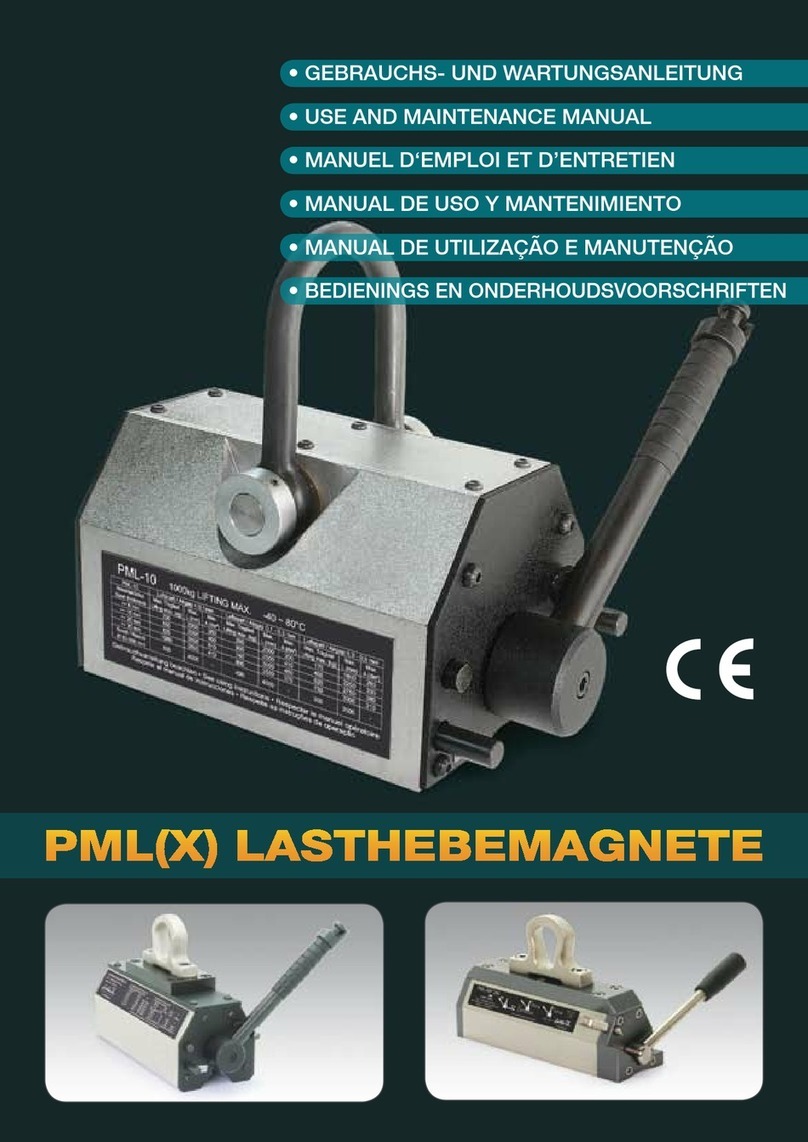
FLAIG TE
FLAIG TE PML Series Use and maintenance manual

Romedis
Romedis Symphonie Aqua operating instructions
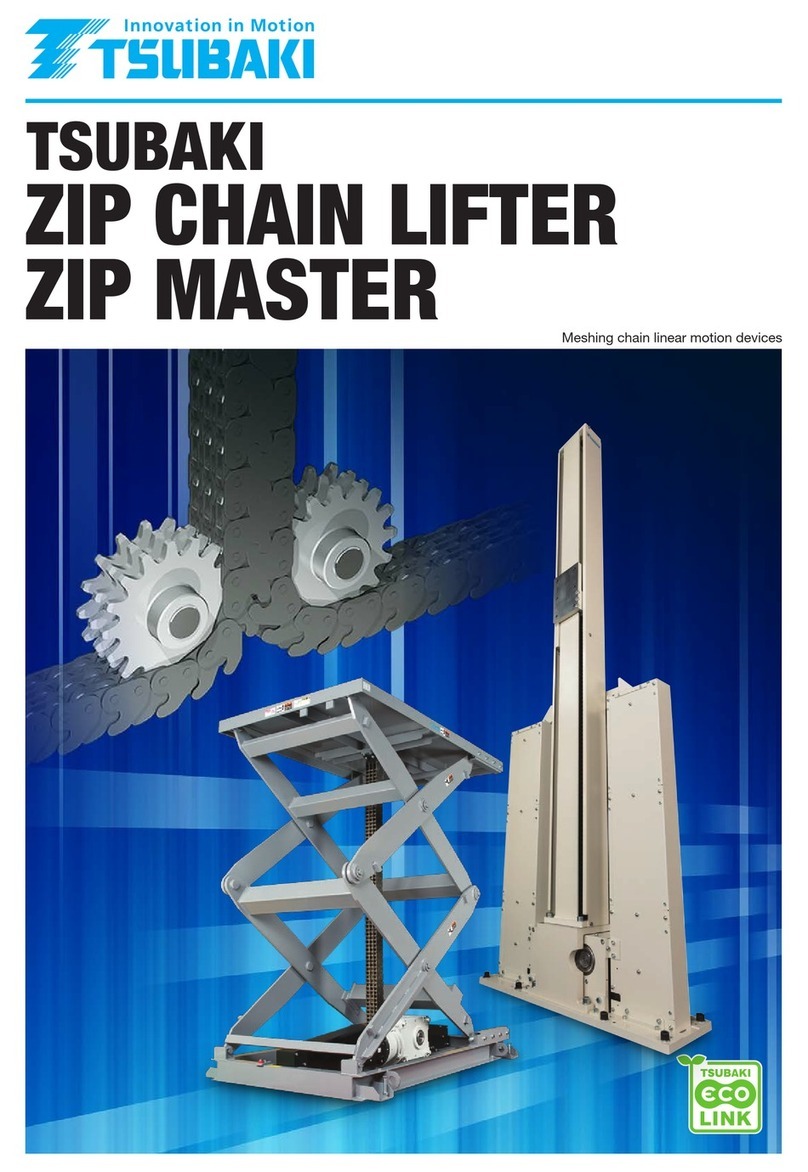
Tsubaki
Tsubaki ZIP CHAIN LIFTER manual

Oxford
Oxford Stature User instruction manual

Pro-Lift
Pro-Lift PL5500 Operating instructions & parts manual

VALLEY CRAFT
VALLEY CRAFT ROTOLIFT-78 AIR instruction manual

